|
Navigation
BOT4404
Main Page
FIU
Home
FIU
Marine Biology Home
Dept.
Biology Home
Frank
Jochem Home
E-Mail
|
Synurophyceans
-
Named
after
genus Synura
-
Silica-scaled
flagellates, separated from chrysophyceans
by their lack of chl.c2 and different flagellar root
-
Autotrophic,
lost ability of phagotrophy
-
Occurrence
predominantly oligotrophic freshwater
-
Flagella
and flagellar roots are parallel (instead
of perpendicular in chrysophyceans), both held in front of cell
-
Flagellar
transformation: the flagella of a given cell
are of different age; only one of the two flagella originates from the
mother cell, the other flagellum is formed after cell division by the daughter
cell
-
Scales
are perforated and may carry perforated spines; produced in silica deposition
vesicles and extruded outside cell membrane; bristles are formed in separate
SDV
-
Silica
depletion results in lack of scales but naked
cells continue to grow

Silicoflagellates
-
External
silicon sceleton is present in at least one
life-cycle stage
-
Few living
species but extensive fossile records
-
Key genus:
Dictyocha
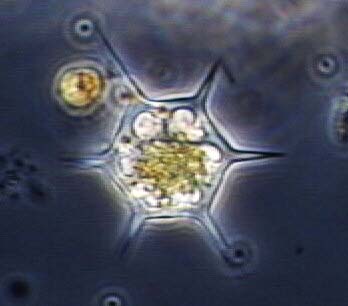 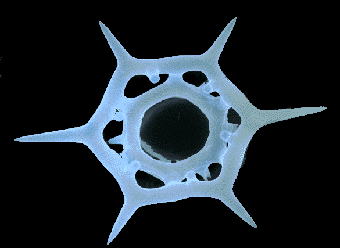
-
Silica
was thought to be necessary for growth
-
Kiel
Bight, Western Baltic: A new phytoplankton
bloom annual blooms discolored the water brown in May, which normally happened
to be the „clearwater phase“; nutrient balance of nitrate:silicate was
altered by eutrophication; Dictyocha speculum adapted to the new
conditions in growing without its typical silica sceleton
Pedinelids
-
Characteristic
genus: Pedinella
-
Unicellular
flagellates with anterior ring of microtubuli-supported
rhizopodia
-
Radial
symmetry around longitudinal axis is exceptional
among algae
-
Unmineralized,
organic scales on cell surface
-
Plastids:
3-6 golden-brown plastids around the cell, containing chl. a,c, fucoxanthin;
heterotrophic species lack plastids
-
Occurrence
predominantely marine

Trybophyceans (Xanthophyceans)
-
Characteristic
genus: Tribonema; group also referred
to as Xantophytes
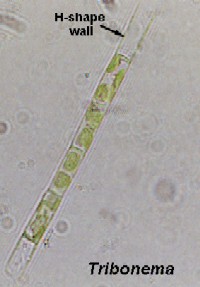
-
Occurrence:
mostly freshwater and soil
-
Cell
wall: cellulose, often H-shaped halves

-
Storage
product: lipids in cytoplasmatic droplets
-
Pigments:
Chl. a, c, diatoxanthin, diadinoxanthin, but fucoxanthin is lacking (appear
yellow-green)
-
Appearance:
unicellular flagellates, coccoid forms, filaments, siphonaceous coenocytes
(tubular multi-nucleolate cells)
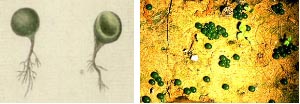
-
Asexual
reproduction by nonflagellate autospores and
aplanospores or flagellated zoospores; thick-walled cysts;
-
Sexual
reproduction by isogamy or oogamy; flagellate
gametes have typical ochrophyte flagella; exception: Vaucheria with
4-flagella male gametes
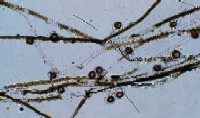 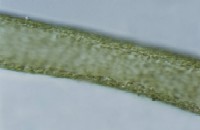 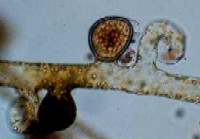 
|








